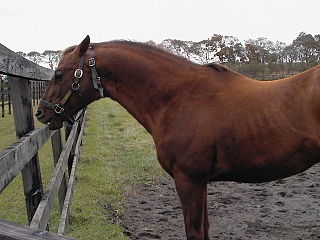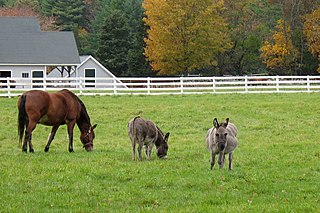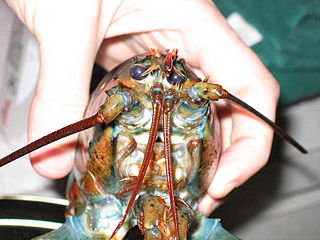
Mink are dark-colored, semiaquatic, carnivorous mammals of the genera Neogale and Mustela and part of the family Mustelidae, which also includes weasels, otters, and ferrets. There are two extant species referred to as "mink": the American mink and the European mink. The extinct sea mink was related to the American mink but was much larger.
A stereotypy is a repetitive or ritualistic movement, posture, or utterance. Stereotypies may be simple movements such as body rocking, or complex, such as self-caressing, crossing and uncrossing of legs, and marching in place. They are found especially in people with autism spectrum disorders and visually impaired children, and are also found in intellectual disabilities, tardive dyskinesia and stereotypic movement disorder, yet may also be encountered in neurotypical individuals as well. Studies have shown stereotypies associated with some types of schizophrenia. Frontotemporal dementia is also a common neurological cause of repetitive behaviors and stereotypies. Several causes have been hypothesized for stereotypy, and several treatment options are available.

Feather-plucking, sometimes termed feather-picking, feather damaging behaviour or pterotillomania, is a maladaptive, behavioural disorder commonly seen in captive birds that chew, bite or pluck their own feathers with their beak, resulting in damage to the feathers and occasionally the skin. It is especially common among parrots, with an estimated 10% of captive parrots exhibiting the disorder. The areas of the body that are mainly pecked or plucked are the more accessible regions such as the neck, chest, flank, inner thigh and ventral wing area. Contour and down feathers are generally identified as the main target, although in some cases, tail and flight feathers are affected. Although feather-plucking shares characteristics with feather pecking commonly seen in commercial poultry, the two behaviours are currently considered to be distinct as in the latter, the birds peck at and pull out the feathers of other individuals.
An ethogram is a catalogue or inventory of behaviours or actions exhibited by an animal used in ethology.

Cribbing is a form of stereotypy (equine oral stereotypic behaviour), otherwise known as wind sucking or crib-biting. Cribbing is considered to be an abnormal, compulsive behavior seen in some horses, and is often labelled a stable vice. The major factors that cause cribbing include stress, stable management, genetic and gastrointestinal irritability.

Animal captivity is the confinement of domestic and wild animals. More specifically, animals that are held by humans and prevented from escaping are said to be in captivity. The term animal captivity is usually applied to wild animals that are held in confinement, but this term may also be used generally to describe the keeping of domesticated animals such as livestock or pets. This may include, for example, animals in farms, private homes, zoos, and laboratories. Animal captivity may be categorized according to the particular motives, objectives, and conditions of the confinement.

Emotion is defined as any mental experience with high intensity and high hedonic content. The existence and nature of emotions in non-human animals are believed to be correlated with those of humans and to have evolved from the same mechanisms. Charles Darwin was one of the first scientists to write about the subject, and his observational approach has since developed into a more robust, hypothesis-driven, scientific approach. Cognitive bias tests and learned helplessness models have shown feelings of optimism and pessimism in a wide range of species, including rats, dogs, cats, rhesus macaques, sheep, chicks, starlings, pigs, and honeybees. Jaak Panksepp played a large role in the study of animal emotion, basing his research on the neurological aspect. Mentioning seven core emotional feelings reflected through a variety of neuro-dynamic limbic emotional action systems, including seeking, fear, rage, lust, care, panic and play. Through brain stimulation and pharmacological challenges, such emotional responses can be effectively monitored.

Behavioral enrichment is an animal husbandry principle that seeks to enhance the quality of captive animal care by identifying and providing the environmental stimuli necessary for optimal psychological and physiological well-being. Enrichment can either be active or passive, depending on whether it requires direct contact between the animal and the enrichment. A variety of enrichment techniques are used to create desired outcomes similar to an animal's individual and species' history. Each of the techniques used is intended to stimulate the animal's senses similarly to how they would be activated in the wild. Provided enrichment may be seen in the form of auditory, olfactory, habitat factors, food, research projects, training, and objects.

Stable vices are stereotypies of equines, especially horses. They are usually undesirable habits that often develop as a result of being confined in a stable with boredom, hunger, isolation, excess energy, or insufficient exercise. They present a management issue, not only leading to facility damage from chewing, kicking, and repetitive motion, but also leading to health consequences for the animal if not addressed. They also raise animal welfare concerns.
Animal psychopathology is the study of mental or behavioral disorders in non-human animals.
Vocal learning is the ability to modify acoustic and syntactic sounds, acquire new sounds via imitation, and produce vocalizations. "Vocalizations" in this case refers only to sounds generated by the vocal organ as opposed to by the lips, teeth, and tongue, which require substantially less motor control. A rare trait, vocal learning is a critical substrate for spoken language and has only been detected in eight animal groups despite the wide array of vocalizing species; these include humans, bats, cetaceans, pinnipeds, elephants, and three distantly related bird groups including songbirds, parrots, and hummingbirds. Vocal learning is distinct from auditory learning, or the ability to form memories of sounds heard, a relatively common trait which is present in all vertebrates tested. For example, dogs can be trained to understand the word "sit" even though the human word is not in its innate auditory repertoire. However, the dog cannot imitate and produce the word "sit" itself as vocal learners can.
Vacuum activities are innate, fixed action patterns (FAPs) of animal behaviour that are performed in the absence of a sign stimulus (releaser) that normally elicit them. This type of abnormal behaviour shows that a key stimulus is not always needed to produce an activity. Vacuum activities often take place when an animal is placed in captivity and is subjected to a lack of stimuli that would normally cause a FAP.

Pain in crustaceans is a scientific debate which questions whether they experience pain or not. Pain is a complex mental state, with a distinct perceptual quality but also associated with suffering, which is an emotional state. Because of this complexity, the presence of pain in an animal, or another human for that matter, cannot be determined unambiguously using observational methods, but the conclusion that animals experience pain is often inferred on the basis of likely presence of phenomenal consciousness which is deduced from comparative brain physiology as well as physical and behavioural reactions.

Abnormal behavior of birds in captivity has been found to occur among both domesticated and wild birds. Abnormal behavior can be defined in several ways. Statistically, 'abnormal' is when the occurrence, frequency or intensity of a behaviour varies statistically significantly, either more or less, from the normal value. This means that theoretically, almost any behaviour could become 'abnormal' in an individual. Less formally, 'abnormal' includes any activity judged to be outside the normal behaviour pattern for captive birds of that particular class or age. For example, running rather than flying may be a normal behaviour and regularly observed in one species, however, in another species it might be normal but becomes 'abnormal' if it reaches a high frequency, or in another species it is rarely observed and any incidence is considered 'abnormal'. This article does not include 'one-off' behaviours performed by individual birds that might be considered abnormal for that individual, unless these are performed repeatedly by other individuals in the species and are recognised as part of the ethogram of that species.
Animal welfare science is the scientific study of the welfare of animals as pets, in zoos, laboratories, on farms and in the wild. Although animal welfare has been of great concern for many thousands of years in religion and culture, the investigation of animal welfare using rigorous scientific methods is a relatively recent development. The world's first Professor of Animal Welfare Science, Donald Broom, was appointed by Cambridge University (UK) in 1986.

A preference test is an experiment in which animals are allowed free access to multiple environments which differ in one or more ways. Various aspects of the animal's behaviour can be measured with respect to the alternative environments, such as latency and frequency of entry, duration of time spent, range of activities observed, or relative consumption of a goal object in the environment. These measures can be recorded either by the experimenter or by motion detecting software. Strength of preference can be inferred by the magnitude of the difference in the response, but see "Advantages and disadvantages" below. Statistical testing is used to determine whether observed differences in such measures support the conclusion that preference or aversion has occurred. Prior to testing, the animals are usually given the opportunity to explore the environments to habituate and reduce the effects of novelty.

Alopecia in animals is a condition where locations on the body surface that are typically covered in hair, contain areas where hair is absent, and is a condition that can affect other animals besides humans. Alopecia is a condition that can affect wild organisms and captive organisms, however, the condition tends to be more prominent in captive contexts. Development of alopecia in animals is usually the sign of an underlying disease. Some animals may be genetically predisposed to hair loss, while in some it may be caused by hypersensitivity or nutritional factors. These include Moluccan cockatoos, spectacled bears, hedgehogs, raccoons, squirrels, baboons, and chimpanzees since they share 98% of human genes. Others that are selectively bred to have baldness include rabbits, guinea pigs, Syrian hamsters, mice, rats, and cats. Environmental enrichment has been used in some cases to mitigate certain behaviours that cause hair loss, improve alopecia, and address welfare concerns.

Lignophagia is the abnormal behaviour of chewing and eating wood. It has been recorded in several species, but perhaps most commonly in horses where it is usually called, simply, "wood chewing". Lignophagia is a form of the pica disorder, in which normally non-nutritive substances are chewed or eaten. For some animals, wood is the normal primary food source; such animals are known as xylophagous.

Christopher M. Sherwin was an English veterinary scientist and senior research fellow at the University of Bristol Veterinary School in Lower Langford, Somerset. He specialised in applied ethology, the study of the behaviour of animals in the context of their interactions with humans, and of how to balance the animals' needs with the demands placed on them by humans.














